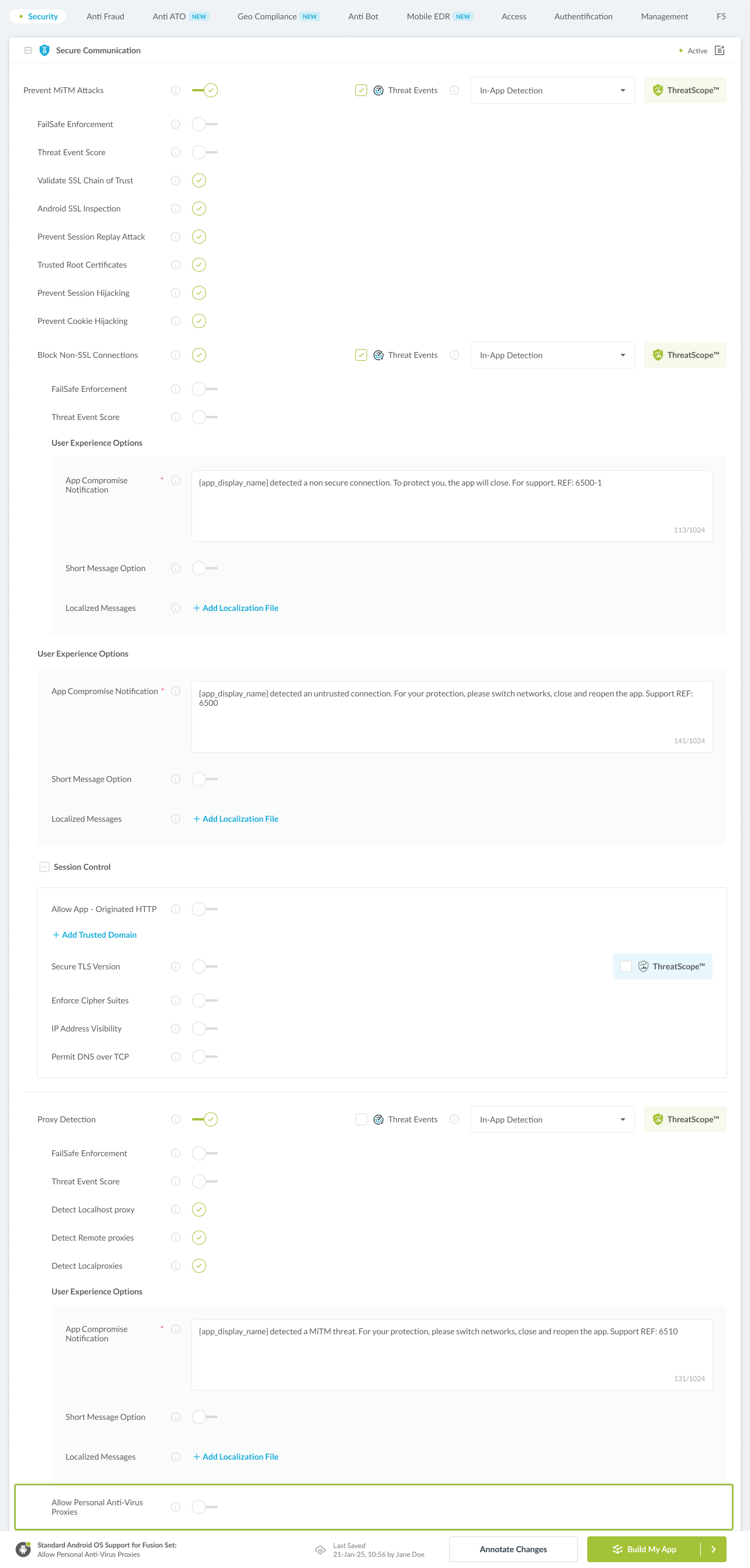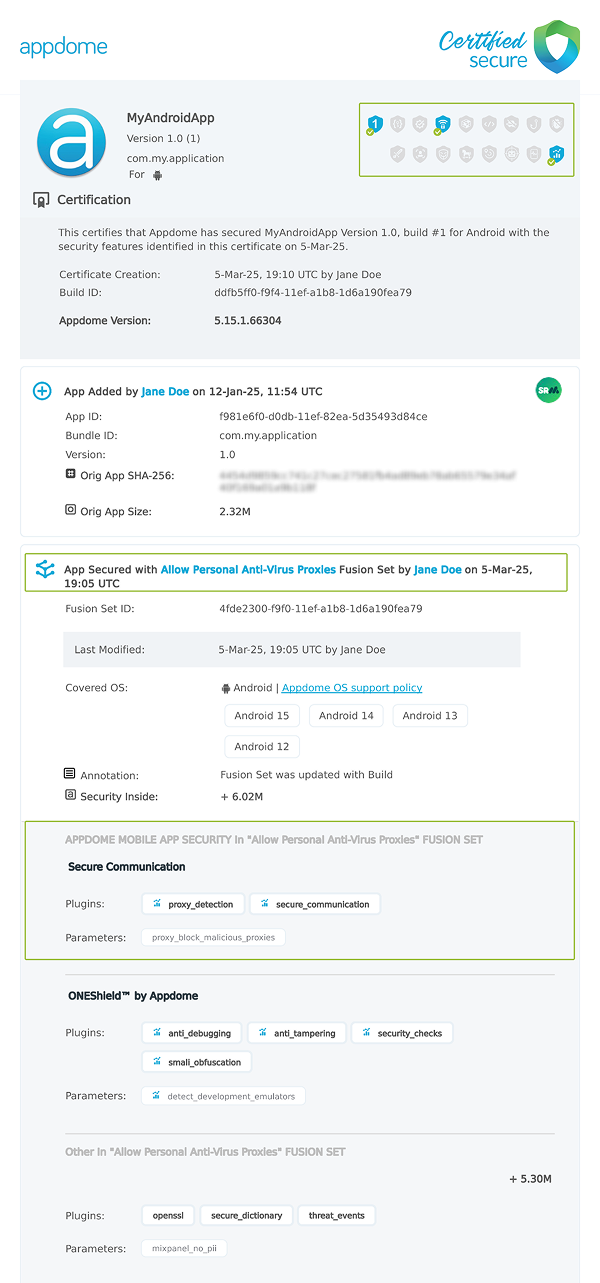Allow Personal Anti-Virus Proxies in Mobile Apps
This Knowledge Base article describes how to use Appdome’s AI/ML in your CI/CD pipeline to continuously deliver plugins that Allow Personal Anti-Virus Proxies in Mobile apps.
What are Anti-Virus Proxies?
Anti-virus proxies are intermediary services that provide security functions between a client’s device and the internet. They inspect web traffic for malicious content, such as viruses, malware, and other cyber threats, before allowing access to or from a network. These proxies can block harmful downloads, filter out dangerous websites, and provide detailed analysis and logging of security threats. By operating as a barrier, anti-virus proxies help to protect end-user devices and internal networks from external security risks.
How Does Appdome's "Trust Personal Anti-Virus Proxies" Feature Work?
Appdome’s Trust Personal Anti-Virus Proxies feature allows the use of trusted personal anti-virus proxies while still providing Deep Proxy Detection and Malicious Proxy Detection to perform deep inspection of proxies and proxying techniques, including header manipulation and redirects.
This feature was developed to address scenarios where benign proxies, such as those set up by Norton 360 for security purposes, are mistakenly identified as risks. By incorporating a sophisticated detection mechanism, Appdome allows these personal anti-virus proxies to function without interference, thereby supporting users’ existing security measures.
This selective detection ensures that only proxies suspected of performing harmful activities, such as intercepting or altering data, trigger a security response. This ensures a smoother user experience and reduces unnecessary security notifications, enabling a focus on genuine threats.
Note on Deep Proxy Detection and Trust Anti-Virus Proxies Interaction:
When ‘Trust Personal Anti-Virus Proxies’ is enabled under the ‘Pin to Host’ settings, ‘Deep Proxy Detection’ is also automatically activated to ensure a comprehensive security approach. If ‘Deep Proxy Detection’ is manually disabled, it will automatically disable ‘Trust Personal Anti-Virus Proxies’ for all host profiles. This linkage is vital for maintaining consistent security measures, ensuring that only verified safe proxies are operational.
Prerequisites for Using Appdome's Allow Personal Anti-Virus Proxies Plugins:
To use Appdome’s mobile app security build system to Allow Personal Anti-Virus Proxies , you’ll need:
Appdome account (create a free Appdome account here)
A license for Allow Personal Anti-Virus Proxies
Mobile App (.ipa for iOS, or .apk or .aab for Android)
Signing Credentials (see Signing Secure Android apps and Signing Secure iOS apps)
How to Implement Allow Personal Anti-Virus Proxies in Mobile Apps Using Appdome
On Appdome, follow these 3 simple steps to create self-defending Mobile Apps that Allow Personal Anti-Virus Proxies without an SDK or gateway:
-
Designate the Mobile App to be protected.
-
Upload an app via the Appdome Mobile Defense platform GUI or via Appdome’s DEV-API or CI/CD Plugins.
-
Mobile App Formats: .ipa for iOS, or .apk or .aab for Android
-
Allow Personal Anti-Virus Proxies is compatible with: Obj-C, Java, JS, C#, C++, Swift, Kotlin, Flutter, React Native, Unity, Xamarin, and more.
-
-
Select the defense: Allow Personal Anti-Virus Proxies.
-
-
Follow the steps in Sections 2.2-2.2.2 of this article to add the Allow Personal Anti-Virus Proxies feature to your Fusion Set via the Appdome Console.
-
When you enable Prevent MiTM Attacks > Proxy Detection you'll notice that the Fusion Set you created in step 2.1 now bears the icon of the protection category that contains Allow Personal Anti-Virus Proxies.

Figure 2: Fusion Set that displays the newly added Allow Personal Anti-Virus Proxies protection
Note: Annotating the Fusion Set to identify the protection(s) selected is optional only (not mandatory). -
Open the Fusion Set Detail Summary by clicking the “...” symbol on the far-right corner of the Fusion Set. Copy the Fusion Set ID from the Fusion Set Detail Summary (as shown below):

Figure 3: Fusion Set Detail Summary
-
Follow the instructions below to use the Fusion Set ID inside any standard mobile DevOps or CI/CD toolkit like Bitrise, Jenkins, Travis, Team City, Circle CI or other system:
-
Refer to the Appdome API Reference Guide for API building instructions.
-
Look for sample APIs in Appdome’s GitHub Repository.
-
Create and name the Fusion Set (security template) that will contain the Allow Personal Anti-Virus Proxies feature as shown below:
Figure 1: Fusion Set that will contain the Allow Personal Anti-Virus Proxies feature
-
-
Add the Allow Personal Anti-Virus Proxies feature to your security template.
-
Navigate to Build > Security tab > Secure Communication section in the Appdome Console.
-
Toggle On Prevent MiTM Attacks > Proxy Detection > Allow Personal Anti-Virus Proxies.

Figure 4: Selecting Allow Personal Anti-Virus Proxies
-
Congratulations! The Allow Personal Anti-Virus Proxies protection is now added to the mobile app -
-
Certify the Allow Personal Anti-Virus Proxies feature in Mobile Apps
After building Allow Personal Anti-Virus Proxies, Appdome generates a Certified Secure™ certificate to guarantee that the Allow Personal Anti-Virus Proxies protection has been added and is protecting the app. To verify that the Allow Personal Anti-Virus Proxies protection has been added to the mobile app, locate the protection in the Certified Secure™ certificate as shown below:

Figure 5: Certified Secure™ certificate
Each Certified Secure™ certificate provides DevOps and DevSecOps organizations the entire workflow summary, audit trail of each build, and proof of protection that Allow Personal Anti-Virus Proxies has been added to each Mobile app. Certified Secure provides instant and in-line DevSecOps compliance certification that Allow Personal Anti-Virus Proxies and other mobile app security features are in each build of the mobile app.
Using Appdome, there are no development or coding prerequisites to build secured Mobile Apps by using Allow Personal Anti-Virus Proxies. There is no SDK and no library to code or implement in the app and no gateway to deploy in your network. All protections are built into each app and the resulting app is self-defending and self-protecting.
Releasing and Publishing Mobile Apps with Allow Personal Anti-Virus Proxies
After successfully securing your app by using Appdome, there are several available options to complete your project, depending on your app lifecycle or workflow. These include:
- Customizing, Configuring & Branding Secure Mobile Apps.
- Deploying/Publishing Secure mobile apps to Public or Private app stores.
- Releasing Secured Android & iOS Apps built on Appdome.
Related Articles:
- How to Enforce Secure Certificate Pinning in Android & iOS Apps
- How to Secure Android & iOS Apps with Pin to Host
- How to Detect Deep Proxy in Android & iOS Apps
How Do I Learn More?
If you have any questions, please send them our way at support.appdome.com or via the chat window on the Appdome platform.
Thank you!
Thanks for visiting Appdome! Our mission is to secure every app on the planet by making mobile app security easy. We hope we’re living up to the mission with your project.
